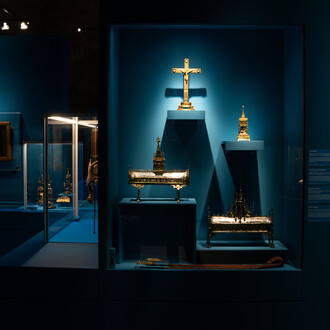From the very beginning, traditional Japanese architecture has been made of wood and has been designed with harmony with the natural environment in mind.
Along the coast of the Sea of Japan, and about a bit over two hours from Tokyo, Toyama Prefecture is becoming a sought-after tourist destination. Bearing a rich history from the Sengoku war period (15th to 16th centuries) and blessed with robust farmlands and flourishing heavy and chemical industries, Toyama is also a haven for culture, art, crafts, and design.
Boasting more than fifteen museums spread across the region, Toyama City has also been named The Glass Art City. The prosperous glass production is attributed to the city’s core manufacture of medicinal drugs, contained in glass bottles. Glass-making expertise found a diverted route towards the development of glass-crafted products. Toyama Institute of Glass Art, Toyama Glass Studio and finally, Toyama Glass Art Museum have all carved Toyama’s reputation of excellence and diligence in the promotion and advancement of glass art production.
At first glance, the exterior facade of Toyama Glass Art Museum stands out like glistening ice dikes of a huge mountain. World-class architect Kengo Kuma precisely envisioned the image of the surrounding Tateyama mountains by combining granite with the city’s indigenous materials—glass and aluminium. The shimmering effect filters through varied angles, diffusing continuous light throughout the city. Further, large, slanted cylinders usher in light beams into the interior and directly onto the floors. Around the light cylinders—cedar boards, glass, and mirrors create magical shadows and reflections—as though the entire structure glows under a forest sunlight.
Opened in 2015, the museum sits inside the TOYAMA KIRARI complex, which also houses the Toyama City Public Library, a local bank, and clinic. The Glass Art Passage from the second to the fourth floor presents approximately fifty works by twenty artists connected with Toyama Prefecture.
The exclusive Glass Art Garden on the sixth floor highlights installations by American glass artist Dale Chihuly, popular for blown glasswork. The stairwell to this stunning art space is bathed in natural light from the ceiling that travels across the galleries. Walking along the corridor, one is greeted by three seaweed-like gleaming chandeliers in yellow, blue, and red—Koki-hi Chandelier (2015), Ruri-iro Chandelier (2015), and Ukon-iro Chandelier (2015). The shadows leave layers of moving patterns around the walls and floors.
Toyama Reeds (2015) in long, numerous blue hand-blown glass spikes erect vertically from Japanese cedar, pine, zelkova, and maple wood. The beautiful, linear impression aligns accordingly to the vertical louvers canopied around the museum.
Looking above, the staggering Toyama Persian Ceiling (2015) consists of a web of multicoloured glass sea creatures, such as octopi, shellfish, starfish, and others, embedded on the ceiling, imitating the sight of an ocean floor. Incredible prisms of coloured lights disperse throughout the gallery space.
All the floors appear to be connected around the slanted Atrium composed of cedar wood shingles, stretched about 10,000 metres. Café Kouma and the Museum Shop on the second floor are, likewise, designed with vertical wood slats on the ceiling, elegantly complementing the wood floor panels and furniture.
Ongoing until January 26th this year is the special exhibition “Commemorating the 120th Anniversary of His Death, Émile Gallé: Longing for Paris.” Émile Gallé is world-recognised as one of the primary leaders of Art Nouveau glass art, ceramics, and furniture, as well as founder of École de Nancy in France. The institution was responsible for the advancement of industrial arts—glassware, furniture, stained glass, ceramics, leather, ironwork, and architecture from 1901. Gallé’s success summited with his presentation of innovative works during the 1878, 1889, and 1900 Paris World Exposition.
The exhibition stages a parade of the artist’s outstanding pieces, predominantly created during his time in Paris. Vase in Shape of Columbine (1898-1900) reveals various techniques with open Columbine flowers and leaves in earth colours, and a pinkish marble foot. The graceful composition and combination of feminine hues exude utter elegance. Another exquisite vessel, Footed Cup with Dragonfly Design (1903-04), depicts a curved dragonfly sliding from the brim to the bottom with its shadows exposed in the glass. It was said that Gallé created the cup at the time of his illness. His G signature at the back of the cup is itself shaped like a dragonfly, which is believed to symbolise himself. The glasswork appears to emit the artist’s spirit, especially in his final moments.
Also on show until June 1st is “Vessels of Light: Exploring Forms of Expression through Glass.” Contemporary artists express the extraction of light through glass by various techniques. Some emphasise the principles of optics, such as the investigation of colour spectrums. Others take inspiration from natural sceneries. Certain works transform the glass object’s form and light itself. Glass functions both as literal vessels and symbolic vessels for light. Some objects separate white light into its various wavelengths and emit rainbow bands. HOUSE (2013) by Osaka artist Katsuya Ohgita glows in blue gradation and is shaped like a block of house. Iwao Matsushima from Okayama has created the fascinating Luminous pool (1999), reminiscent of antique cone-formed glass vessels. Many participating artists represent Czechia like Pavel Hlava, Stanislav Libenský and Jaroslava Brychtová, Marian Karel, and more.
Experiencing the brilliance of the museum’s architecture and artworks is a perfect gateway to appreciate the majestic glass city of Toyama.









